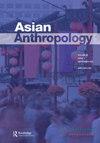Lithic devotionality and other aesthetic strata: Buddhist garden shrines in rural Java
Q2 Social Sciences
引用次数: 0
Abstract
Abstract In this article I explore the contemporary practice of establishing garden shrines in Buddhist rural Java. While on the surface the placement of shrines follows the demands of environmental upgrading and beautification strategies, often in accord with eco-tourist imaginaries, the practice reveals a complex aggregation of material and discursive threads. The article situates the project, ethnographically, as a sensorial practice in which environmental awareness and a sense of “atmosphere” are directly involved. This perceptual domain, particularly the relationship of the villagers to the Sakyamuni statuettes, is simultaneously articulated in continuity with the religious field of Javanese Buddhism, as it encompasses notions of sacralization and rituality. I recover the idea of aesthetic practice in order to bring these sensorial stems on a common platform. In blending discursive and materialist approaches, the article converses with the idea of strata as devised by Deleuze and Guattari as a pivotal image in their work on rhizomes. Through the concept of stratification, I argue, it is possible to apprehend Buddhist shrines as cultural formations in which “everything is involved,” that is, as multiplicities in which layers of materiality and discourse are intertwined in meaningful and generative ways.石器时代的虔诚和其他审美层次:爪哇农村的佛教花园神社
摘要本文探讨爪哇佛教乡村园林神祠的当代建设实践。虽然从表面上看,神龛的放置遵循环境升级和美化策略的要求,通常符合生态游客的想象,但这种做法揭示了材料和话语线索的复杂聚合。文章从民族志的角度将该项目定位为一种感官实践,其中直接涉及环境意识和“氛围”感。这种感知领域,特别是村民与释迦牟尼雕像的关系,同时也与爪哇佛教的宗教领域保持连续性,因为它包含了圣化和仪式的概念。我恢复了审美实践的概念,以便将这些感官系统放在一个共同的平台上。在混合话语和唯物主义的方法中,文章与德勒兹和瓜塔里设计的分层概念进行了对话,作为他们对根茎的研究中的关键形象。我认为,通过分层的概念,有可能将佛教神社理解为“一切都涉及其中”的文化形态,也就是说,将其理解为多重性,其中物质和话语的层次以有意义和生成的方式交织在一起。
本文章由计算机程序翻译,如有差异,请以英文原文为准。
求助全文
约1分钟内获得全文
求助全文
来源期刊

Asian anthropology
Social Sciences-Anthropology
CiteScore
1.60
自引率
0.00%
发文量
25
期刊介绍:
Asian Anthropology seeks to bring interesting and exciting new anthropological research on Asia to a global audience. Until recently, anthropologists writing on a range of Asian topics in English but seeking a global audience have had to depend largely on Western-based journals to publish their works. Given the increasing number of indigenous anthropologists and anthropologists based in Asia, as well as the increasing interest in Asia among anthropologists everywhere, it is important to have an anthropology journal that is refereed on a global basis but that is editorially Asian-based. Asian Anthropology is editorially based in Hong Kong, Taiwan, and Japan, but welcomes contributions from anthropologists and anthropology-related scholars throughout the world with an interest in Asia, especially East Asia as well as Southeast and South Asia. While the language of the journal is English, we also seek original works translated into English, which will facilitate greater participation and scholarly exchange. The journal will provide a forum for anthropologists working on Asia, in the broadest sense of the term "Asia". We seek your general support through submissions, subscriptions, and comments.
 求助内容:
求助内容: 应助结果提醒方式:
应助结果提醒方式:


